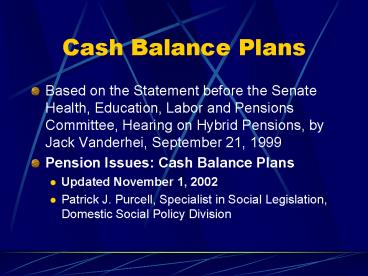Cash Balance Plans
1 / 13
Title: Cash Balance Plans
1
Cash Balance Plans
- Based on the Statement before the Senate Health,
Education, Labor and Pensions Committee, Hearing
on Hybrid Pensions, by Jack Vanderhei, September
21, 1999 - Pension Issues Cash Balance Plans
- Updated November 1, 2002
- Patrick J. Purcell, Specialist in Social
Legislation, Domestic Social Policy Division
2
Cash Balance plan
- Legally, defined benefit
- Looks like DC
- Individual hypothetical account
- But commingled funds
- Investments determined by employer
- Annual growth by credits based on flat percentage
of pay - May integrate with Social Security
- Guaranteed Yield
- Determined by employer
- Usually, 30 year Treasury rate, or Tbill
- Pre-retirement separation from service has lump
sum option
3
Advantages to the employer
- Appreciated by younger employees
- Lower costs
- Contribution based on percent of pay, which
basically career averages, not FAC - Guaranteed rate is conservative
- More predictable expenses
4
Advantages of Cash Balance
- Ease of communication
- Account balance vs. benefit formula
- 1/3 of workers do not know their benefits
- 2/3 of workers have wrong information about early
retirement (Mitchell, 1988)
5
Advantages of Cash Balance over DB
- Benefits accrue more evenly over plan life
- Easier to leave the plan
- Matches more mobile workforce
- Figure 4
6
Advantages of Cash Balance over DC
- Easier to convert DB to CB than to DC
- Avoid 20 or 50 excise tax for over funded plans
- Guaranteed employee participation
- Retirement not influenced by bull (bear) market
- May have more funding flexibility
7
Advantages of Cash Balance over DC (cont.)
- Benefits predictably adequate
Age 401(k) participants with no exposure to diversified equities
20s 28
30s 26
40s 29
50s 32
60s 46
8
Number of Retirement Plans 1975-1997 Number of Retirement Plans 1975-1997 Number of Retirement Plans 1975-1997 Number of Retirement Plans 1975-1997 Number of Retirement Plans 1975-1997 Number of Retirement Plans 1975-1997 Number of Retirement Plans 1975-1997
1975 1980 1985 1990 1994 1997
Private Industry 311,094 488,901 632,135 712,308 690,344 700,000
Defined Benefit 103,346 148,096 170,172 113,062 74,422 53,000
Defined Contribution 207,748 340,805 461,963 599,245 615,922 647,000
State and Local Government 3,075 3,075 2,589 2,387 N/A N/A
Federal Government 2 2 2 4 4 4
9
Total Retirement Plan Participation 1975-1997 (in millions) Total Retirement Plan Participation 1975-1997 (in millions) Total Retirement Plan Participation 1975-1997 (in millions) Total Retirement Plan Participation 1975-1997 (in millions) Total Retirement Plan Participation 1975-1997 (in millions) Total Retirement Plan Participation 1975-1997 (in millions) Total Retirement Plan Participation 1975-1997 (in millions)
1975 1980 1985 1990 1994 1997
Private Industry 44.5 57.9 74.7 76.9 85.1 86.0
Defined Benefit 33.0 38.0 39.7 38.8 40.3 40.0
Defined Contribution 11.5 19.9 35.0 38.1 44.8 46.0
State and Local Government 11.0 14.7 15.2 16.9 13.3 N/A
Federal Government N/A 6.4 8.6 10.7 10.8 N/A
10
Table 2. Worker Spending a Full Career with One Employer, Table 2. Worker Spending a Full Career with One Employer, Table 2. Worker Spending a Full Career with One Employer, Table 2. Worker Spending a Full Career with One Employer, Table 2. Worker Spending a Full Career with One Employer, Table 2. Worker Spending a Full Career with One Employer,
Beginning at Age 25 Beginning at Age 25 Beginning at Age 25
Present value of benefit or of Present value of benefit or of Monthly annuity beginning Monthly annuity beginning
account balance account balance at age 65 at age 65
Age Annual salary Traditional DB plan Cash-balance plan Traditional DB plan Cash-balance plan
25 20,000 0 0 0 0
30 24,300 3,086 5,179 138 232
35 29,600 9,997 13,192 342 452
40 34,300 23,148 27,683 607 725
45 39,750 46,763 48,287 937 968
50 46,100 88,564 80,970 1,359 1,242
55 53,400 161,022 126,531 1,890 1,485
60 61,900 284,630 189,375 2,556 1,701
62 65,700 355,299 220,600 2,867 1,780
65 71,800 492,858 275,333 3,386 1,892
Source Estimates prepared by the Congressional Research Service. Source Estimates prepared by the Congressional Research Service. Source Estimates prepared by the Congressional Research Service. Source Estimates prepared by the Congressional Research Service. Source Estimates prepared by the Congressional Research Service. Source Estimates prepared by the Congressional Research Service.
11
Table 3. Worker Spending Career with Four Employers, Table 3. Worker Spending Career with Four Employers, Table 3. Worker Spending Career with Four Employers, Table 3. Worker Spending Career with Four Employers, Table 3. Worker Spending Career with Four Employers, Table 3. Worker Spending Career with Four Employers,
Beginning at Age 25 Beginning at Age 25 Beginning at Age 25
Present value of benefit or of Present value of benefit or of Monthly annuity beginning Monthly annuity beginning
account balance account balance at age 65 at age 65
Age Annual salary Traditional DB plan Cash-balance plan Traditional DB plan Cash-balance plan
25 20,000 0 0 0 0
30 24,300 3,086 5,179 138 232
35 29,600 9,997 13,192 342 452
40 34,300 20,782 29,285 545 781
45 39,750 40,457 54,233 811 1,087
50 46,100 70,589 97,548 1,083 1,496
55 53,400 122,781 161,135 1,441 1,891
60 61,900 201,132 260,765 1,806 2,342
62 65,700 245,826 312,697 1,983 2,523
65 71,800 332,943 407,079 2,288 2,797
Source Estimates prepared by the Congressional Research Service. Source Estimates prepared by the Congressional Research Service. Source Estimates prepared by the Congressional Research Service. Source Estimates prepared by the Congressional Research Service. Source Estimates prepared by the Congressional Research Service. Source Estimates prepared by the Congressional Research Service.
12
Disadvantages of Conversion from DB to Cash
Balance
- Smaller accruals for older workers
- Workers less certain of their own income
replacement ratio - Increased use of lump-sum distributions
- Longevity risk
- Post-retirement investment risk
13
Other issues
- Almost all conversions have supplemental
transition benefits or grandfathering for older
workers - Wearaway
- Upon conversion, the participants cash balance
may be less than already accrued benefits - No contributions until caught up































